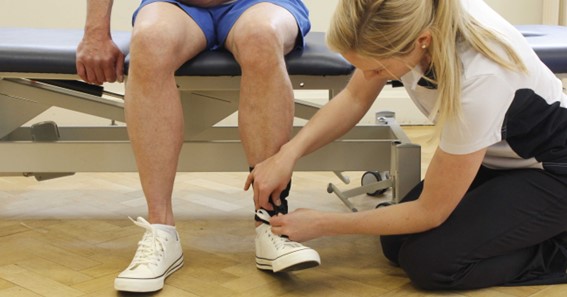The foot, ankles, knees, and back are connected. Therefore, an improper gait or posture can affect the body, causing pain. Usually, issues with the foot affect the back, knees, and ankle. Fortunately, orthotics can support and align specific areas in the body to reduce pain. A physiotherapist in Surrey, BC, assesses the effectiveness of orthotics for patients, prescribing and fitting one to suit their needs. This article explores the role of a physiotherapist in fitting orthotics to relieve pain at Cambie Physiotherapy.
What are Orthotics?
Orthotics are custom-made devices fitted to support and align specific body areas. This device can help treat several conditions in the feet, ankles, knees, and back. Conditions that can benefit from orthotics include plantar fasciitis, osteoarthritis, and scoliosis.
What Conditions do Orthotics Treat?
As mentioned earlier, orthotics treat several feet, ankle, knee, and back conditions. These conditions include:
Foot and ankle conditions
- Plantar fasciitis: is the inflammation of the thick band of tissue connecting the heel bone to the toes. The inflammed tissue runs across the foot’s bottom, causing stabbing pain. Custom orthotics in Richmond, BC, can provide comfort and alleviate pain resulting from plantar fasciitis. In addition, the device minimizes the stretching of the plantar fascia when standing or walking, reducing stress.
- Flat feet: when the foot’s arch is lower than usual. This condition may result in foot pain, especially in the heel or arch area. It may also cause swelling along the insides of the ankles. This pain and swelling may worsen with activity. Custom orthotics provide support for the feet, preventing knee or ankle pain. The device may also postpone or prevent the need for surgery.
- Achilles tendinitis: is when there is an injury in the Achilles tendon, which connects the calf muscle to the heel bone. Custom orthotics like insoles provide heel support and absorbs shock. It also controls excessive movement, reducing strain on the Achilles tendon.
Knee conditions
- Patellofemoral pain syndrome: is a condition that causes pain around the kneecap. This condition results from damage or overuse of the cartilage under the kneecap. Custom orthotics can improve foot movement and cushion the feet, supporting it and making it easier to maintain a good posture.
- Osteoarthritis: is a degenerative joint disease resulting from wear and tear that can cause knee pain. Orthotics can prevent instability and reduce excessive stress on the joint, reducing the symptoms of osteoarthritis.
- IT band syndrome: is a condition that causes pain on the outside of the knee. Custom orthotics can reduce pain from IT band syndrome by supporting the foot and lower leg motions, dispersing the impact the feet and body experience when walking.
Back conditions
- Scoliosis: is a condition where the spine curves to the side, resulting in pain and disability. Orthotics can prevent the spinal curve’s progression, helping maintain a normal back appearance.
- Disc Herniation: is a condition where the soft tissue between the vertebrae of the spine bulges out, irritating nearby nerves and causing pain. Because back issues often stem from poor foot structure, custom orthotics can distribute weight properly to the right joints. This then reduces pain and improves your gait.
- Spinal stenosis: is a condition where the spinal canal narrows, putting pressure on the nerves in the spine. Custom orthotics provide proper support and stabilize foot alignment to reduce pain from spinal stenosis.
What are the Benefits of using Orthotics?
Orthotics improve alignment between the foot, ankles, knee and back. The device evenly distributes weight to improve gait and posture. The benefits of orthotics include pain relief and improved function. In addition, the device enhances balance to allow for easier movement.
Furthermore, orthotics prevent the risk of reinjury by reducing strain and providing support for the affected area.
What is the Role of a Physiotherapist in Orthotics?
A physiotherapist assesses your condition and symptoms to determine if orthotics are necessary. The orthotics are custom-made to suit your specific needs. Consequently, physiotherapy in Richmond will assess your gait, posture, muscle strength and range of motion. Your lifestyle and daily activities are also considered before your physiotherapist prescribes orthotics.
How Do Physiotherapists Fit Orthotics?
After your physiotherapist in Richmond and Surrey, BC, determines that an orthotic is necessary for your condition, the next step is to fit it.
During fitting, your physiotherapist will take a digital scan or mold of your foot, knee, ankle or back. The scan represents the area that needs orthotics, and it helps your physiotherapist create an orthotic that meets your specific need.
After creating the image, your physiotherapist will customize the orthotic using materials that suit your condition. You will then go for a fitting, and your physiotherapist will make the necessary adjustments, ensuring the orthotic is comfortable and effective.
Your physiotherapist will also check regularly to see if the orthotic is effective. An effective orthotic should minimize your symptoms and provide comfort.
Do You Need Physiotherapy Exercises in Addition to Orthotics?
Yes, physiotherapy exercises can improve your joint stability and strength. They can also improve balance, flexibility, and range of motion. In addition, your physiotherapist in Richmond, BC, will also recommend strengthening, stretching, and coordination exercises to alleviate pain and improve your strength.
Conclusion
Orthotics improve alignment and balance, alleviating pain and reducing your risk of falling. Your physiotherapist assesses your symptoms and condition to prescribe and fit a custom orthotic properly. If you experience persistent pain in your feet, ankles, knees, or back, it is best to visit Cambie Physiotherapy for an evaluation and customized orthotics.






